Galls: Nature's most beautiful, horrifying and intriguing parasites
A playground for aphids, wasp eggs, and funghi — galls come in all shapes and sizes
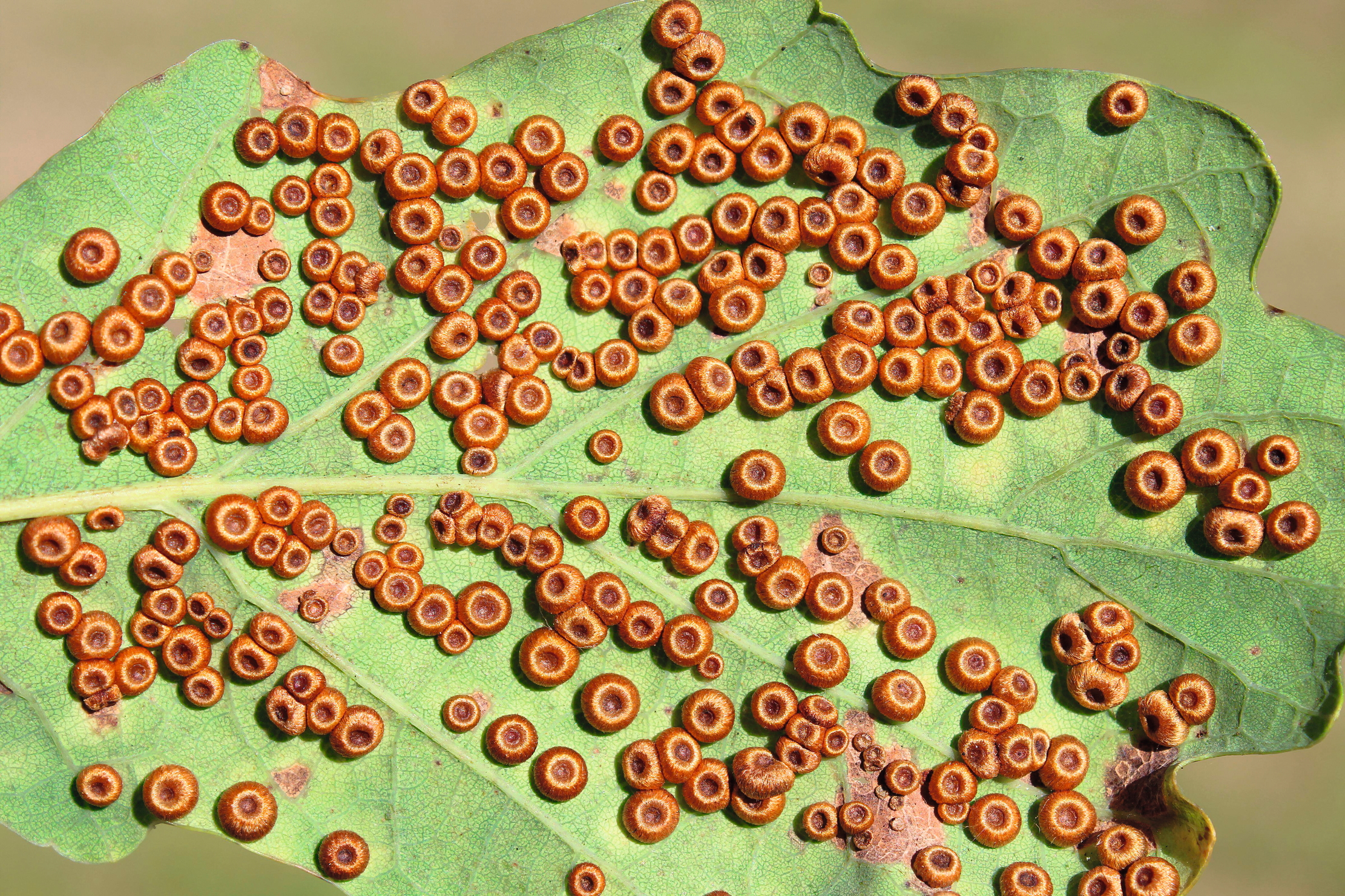

Some are pinned to leaves like delicate jewel brooches, whereas others are disfiguring bulbous growths that squat on plants like alien invaders. Galls — abnormal growths on plants and trees caused by parasitic organisms — are among the most intriguing of Nature’s creations and can be both beautiful and horrifying.
The charming cherry gall, for example, adorns oak leaves with delicately speckled red baubles and the unseemly horned oak gall wraps itself around branches like the clawed toes of a hideous monster. All capture the imagination and all are formed from the plant’s own tissue, altered by physical injury or alchemised by chemical secretions.
The most common culprits are invertebrates: often tiny gall wasps, less than half an inch in length, or flies, mites and aphids. As aphids nibble plants, chemicals in their saliva induce the formation of galls, creating pop-up furniture among which they can feed and reproduce. For other invertebrates, such as wasps, laying their eggs on a plant stimulates the growth of a gall, which cocoons the larvae in a protective and edible nursery, rather like a chick within an egg.
Due to the range of insects engaging with it, and the many different places on a plant that a gall can form (leaves, catkins, buds, acorns or roots, each with a differing result), a single species of plant can yield an abundant variety of galls. In the UK, about 70 different gall wasps interact with oak, for example, creating an entire curiosity cabinet of galls with evocative names, such as the artichoke, the marble and the silk button.
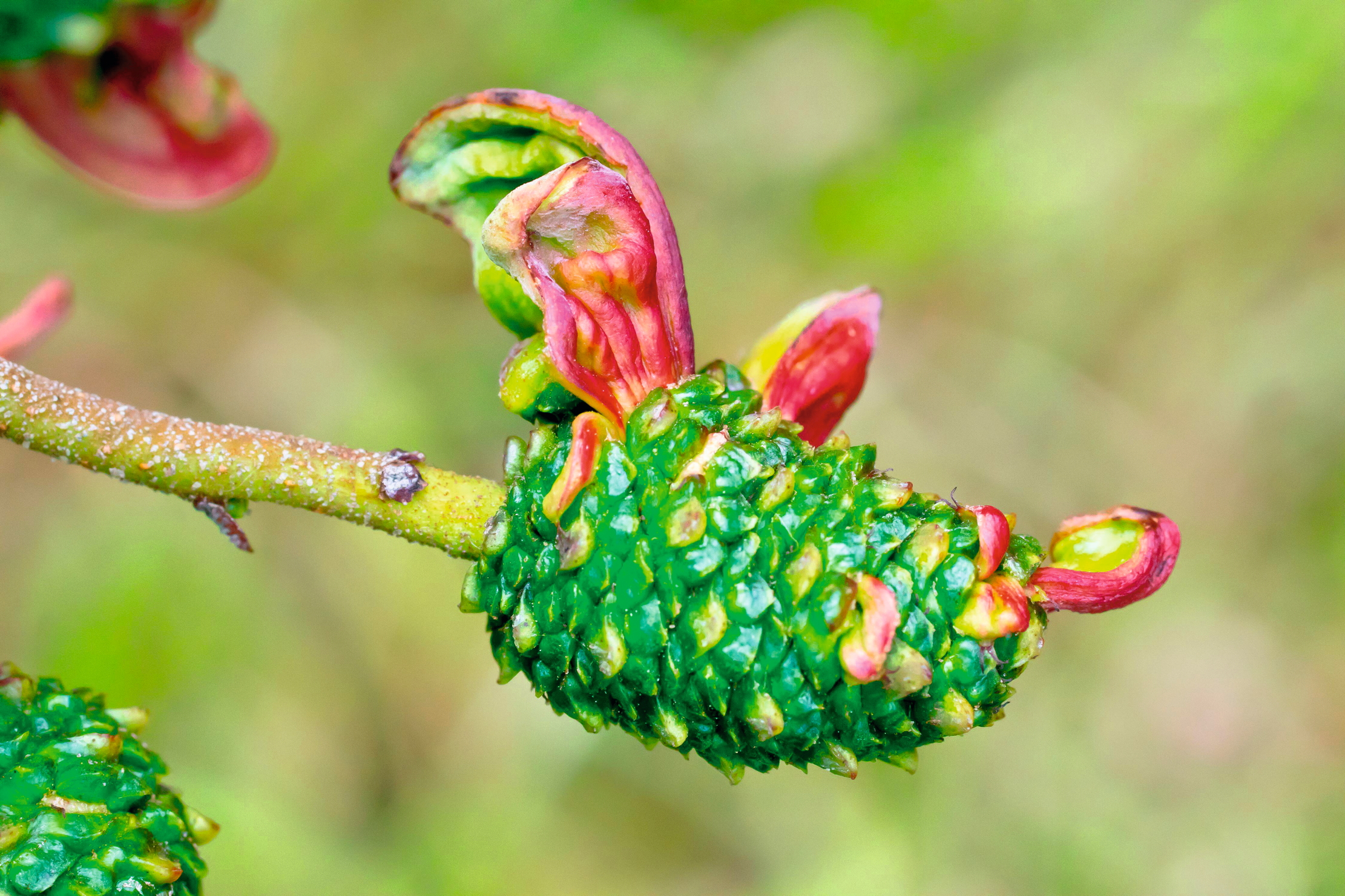
Alder tongue galls on an alder catkin.
The ecologist and Nature photographer Alan Watson Featherstone (founder of the rewilding charity Trees For Life) has spied many extraordinary galls in the Caledonian Forest in north-east Scotland, where he lives. ‘The most interesting gall for me is the robin’s pincushion gall,’ he says; he occasionally cuts them open to photograph the larvae inside. Induced by a wasp (Diplolepis rosae) on dog rose (Rosa canina), ‘it manifests either as an individual gall, with narrow bright red spikes to it, or as a cluster of up to 60 galls grouped together’.
These prickly forms can be an arena for a deadly battle of the bugs. Fourteen different insects have been recorded emerging from them, notes Alan, including ‘various parasitoids and hyperparasitoids, which feed on and kill the larva of the inducing wasp, or a larva of another wasp that has parasitised it’.
Occasionally, galls emit a slight whiff that hints at these tenants within. Some oak galls, for example, have a somewhat ‘bug-like’ odour that emanates from their occupiers and helps deter predators, according to Edward T. Connold’s British Oak Galls (1908). Other researchers quoted in the book describe the aroma in more sommelier-like terms, claiming that it evokes ripe apples, caramel, lemon or malt.
Exquisite houses, the beauty of Nature, and how to get the most from your life, straight to your inbox.
Whatever the smell, the flavour is rather hit and miss. High in tannic acid, most galls cause a nasty tummy ache. One exception is the fragrant apple-like gall of the apple sage (Salvia pomifera), which some consider a delicacy when preserved in sugar. Intrepid researchers who have taste tested oak galls have found huge variations according to species. The rind of the barnacle gall, reports Connold, is ‘slightly sweet’, for example, and the common spangle gall, when formed on catkins, is described as ‘soft and very juicy’, although the larva inside is ‘slightly acidic in taste’.
Fungi can also induce galls, but, in the UK, they are mostly inedible. They do play an interesting role in our ecosystem, however, enabling the fungus, Alan says, ‘to live in a substrate in which it would otherwise not be able to thrive’. One example is the scruffy witch’s broom fungus, which resembles a bird’s nest. ‘Those galls persist for years, enabling the fungus to live much longer,’ he notes. ‘Additionally, because the witch’s broom gall often appears high up on a birch tree, it provides more exposure to air currents and the wind, which can help by transporting the fungus’s spores over a significantly greater distance.’
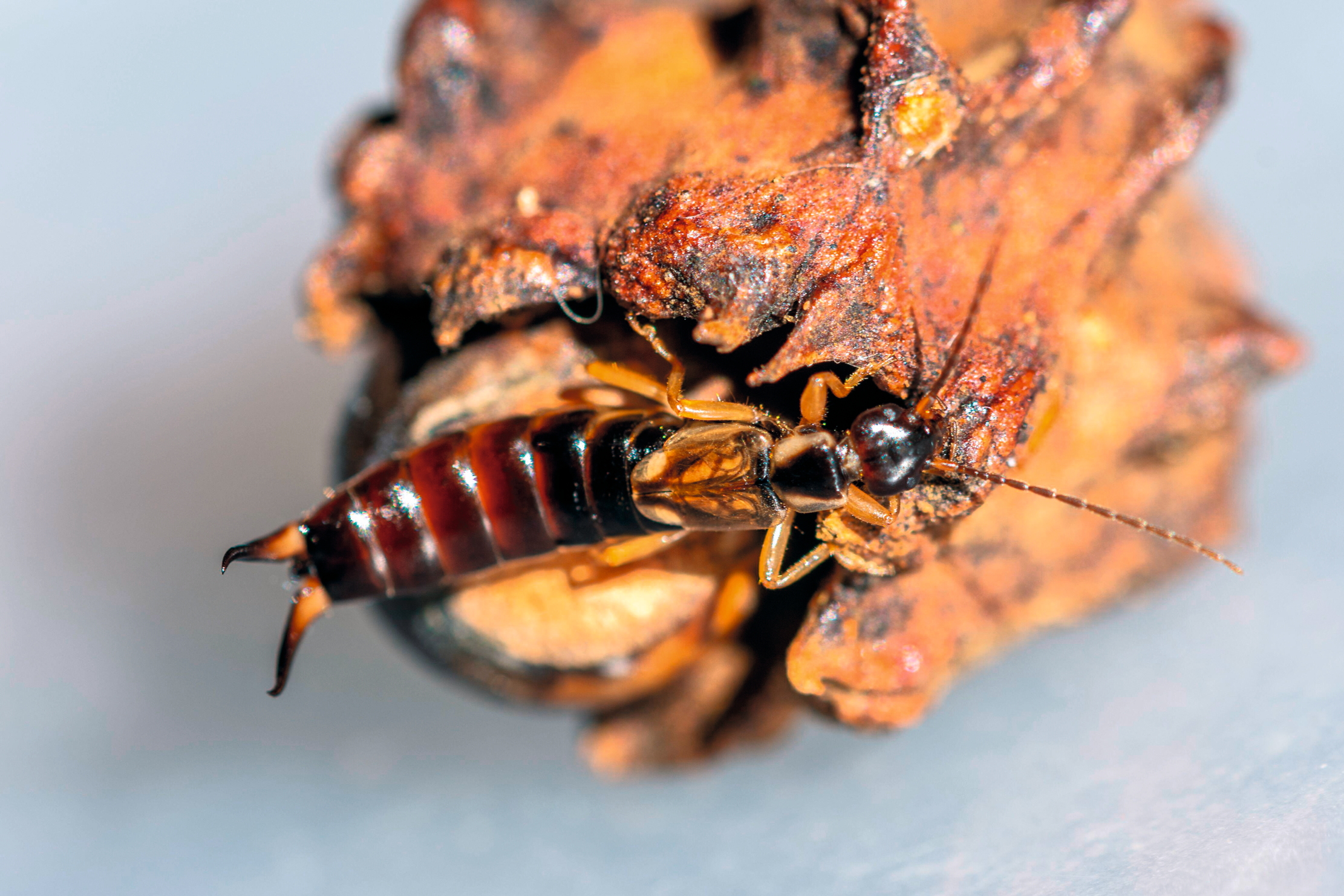
An earwig explores an oak knopper gall enveloping an acorn.
'The appearance of witch's broom gall in a treetop was thought to be a sign that a witch had recently flown over it'
In times past, the unfathomable origin of these bizarre protuberances spawned various supernatural explanations, as suggested by their names. Robin’s pincushion galls were attributed to the mischievous woodland sprite Robin Goodfellow (better known as Shakespeare’s Puck), and the appearance of witch’s broom gall in a treetop was thought to be a sign that a witch had recently flown over it.
In the Middle Ages, galls were even used to tell the future, as explained by Lucy Clausen in 1954’s Insect Fact and Folklore. ‘The gall, upon being opened, was supposed to contain a maggot, a fly, or a spider,’ she writes. ‘If it was a maggot, it betokened that the coming year would bring famine; if a fly, it forecast war; and if a spider, pestilence.’ Later, a worm came to denote ‘plenty,’ she explains. It’s arguable that it was the most nourishing of the three options.
Even more mysterious, perhaps, are the viruses and bacteria that can also cause galls, which are often harder to determine. Although they disfigure the plant, they are not entirely bad news. The bacteria Rhizobium, for example, which causes knobbly growths on the roots and stems of some legumes, converts nitrogen in the air into ammonia that feeds the host plant.
In fact, the biggest misunderstanding about galls, Alan explains, is that they harm their host. ‘That would not serve the purpose of the gall-inducing organism at all as it needs its host plant to stay healthy, so that it can continue to feed off it,’ he stresses. ‘I often think of it as being a bit like a wart on my hand: apart from being visually unattractive, it doesn’t really cause me any adverse effects.’
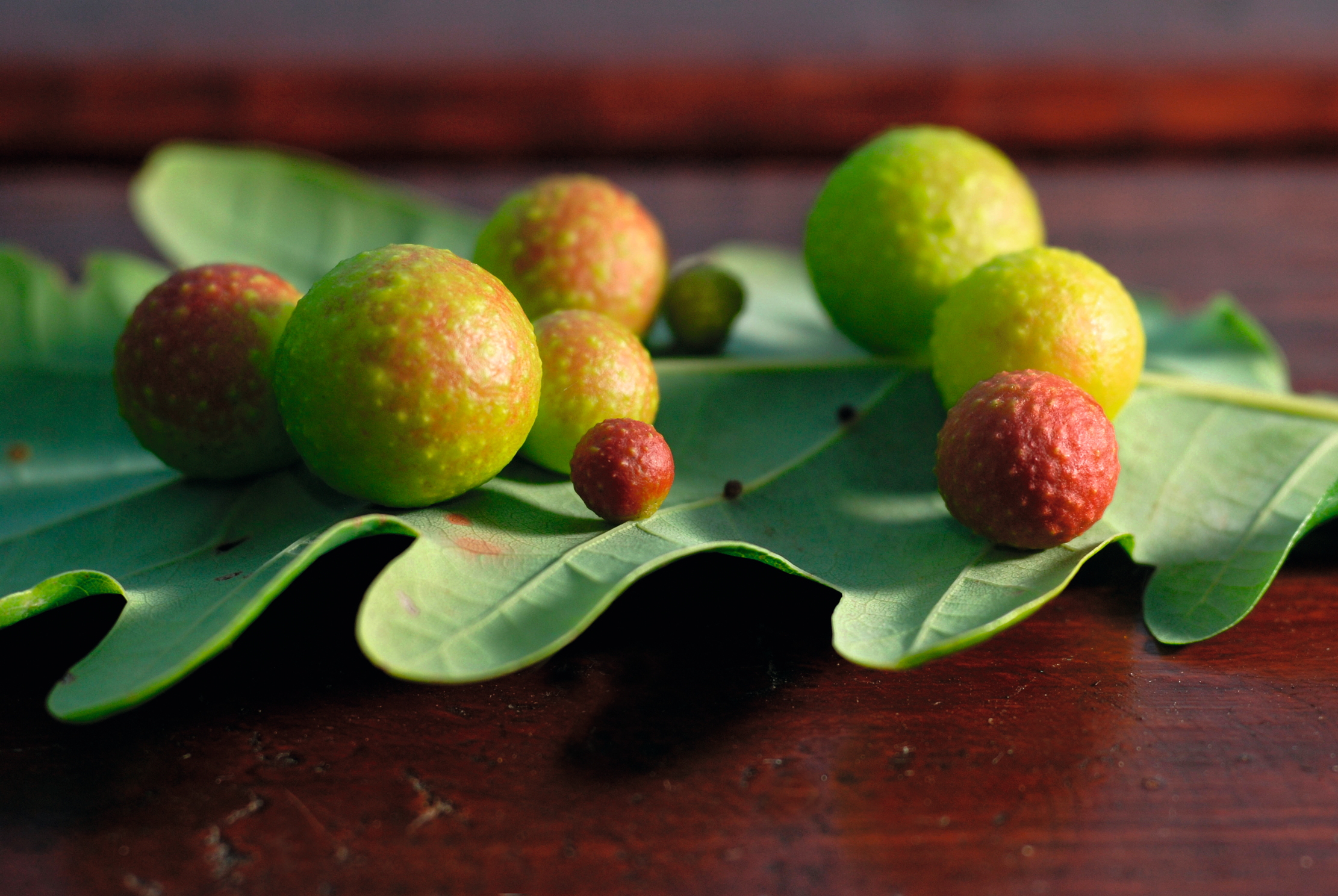
Oak apple and cherry galls. The tannins from the oak gall were used to make ink, that was then used to sign the US Declaration of Independence.
Someone should have told all this to Shakespeare, who repeatedly makes the gall a symbol of malevolence. Love in Romeo and Juliet is described as ‘a choking gall and a preserving sweet’, for example. In Hamlet, Laertes warns Ophelia of innocence’s susceptibility to corruption, asserting that ‘the canker galls the infants of the spring’.
In fact, despite their negative connotations in literature, galls are actually miniature pharmacies that supposedly offer centuries-old remedies for everything from rabies to hair loss, as recorded in the writings of Pliny the Elder and supported by the discovery in 1961 at the foot of Mount Vesuvius in Italy of a clay dolia containing almost 3,000 medicinal galls, thought to date back to a volcanic eruption in AD79. A recent study focused on oak galls, undertaken at the University of Medicine and Pharmacy in Cluj-Napoca, Romania, appears to confirm their healing properties, noting ‘the strong antioxidant capacity and anti-inflammatory effects and antibacterial, antifungal, antimalarial and antitumor activities of oak gall extracts, as well as the anti-ageing skin properties’.
Not only has the gall helped ensure our continuation, it has also charted our history with its juices. The Magna Carta, which laid the foundations for a democratic Britain, and the US Declaration of Independence of 1776, which sent us packing, were both written in ink created from the oak gall’s rich tannins. Despite his disparaging use of galls in his literary metaphors, Shakespeare still used its ink to pen his famous works. Even Will’s will was written in gall ink. ‘I gyve vnto my wief my second best bed with the furniture,’ he wrote. A lacklustre legacy that any modern wife would find most galling.
Deborah Nicholls-Lee is a freelance feature writer who swapped a career in secondary education for journalism during a 14-year stint in Amsterdam. There, she wrote travel stories for The Times, The Guardian and The Independent; created commercial copy; and produced features on culture and society for a national news site. Now back in the British countryside, she is a regular contributor for BBC Culture, Sussex Life Magazine, and, of course, Country Life, in whose pages she shares her enthusiasm for Nature, history and art.
-
 'A masterpiece of timeless elegance' for sale on the charmed Surrey estate once owned by Henry VIII and the Guinness family
'A masterpiece of timeless elegance' for sale on the charmed Surrey estate once owned by Henry VIII and the Guinness familyThe Manor House in Burwood Park is a grand, enormous and undeniably impressive. Annabel Dixon takes a look.
-
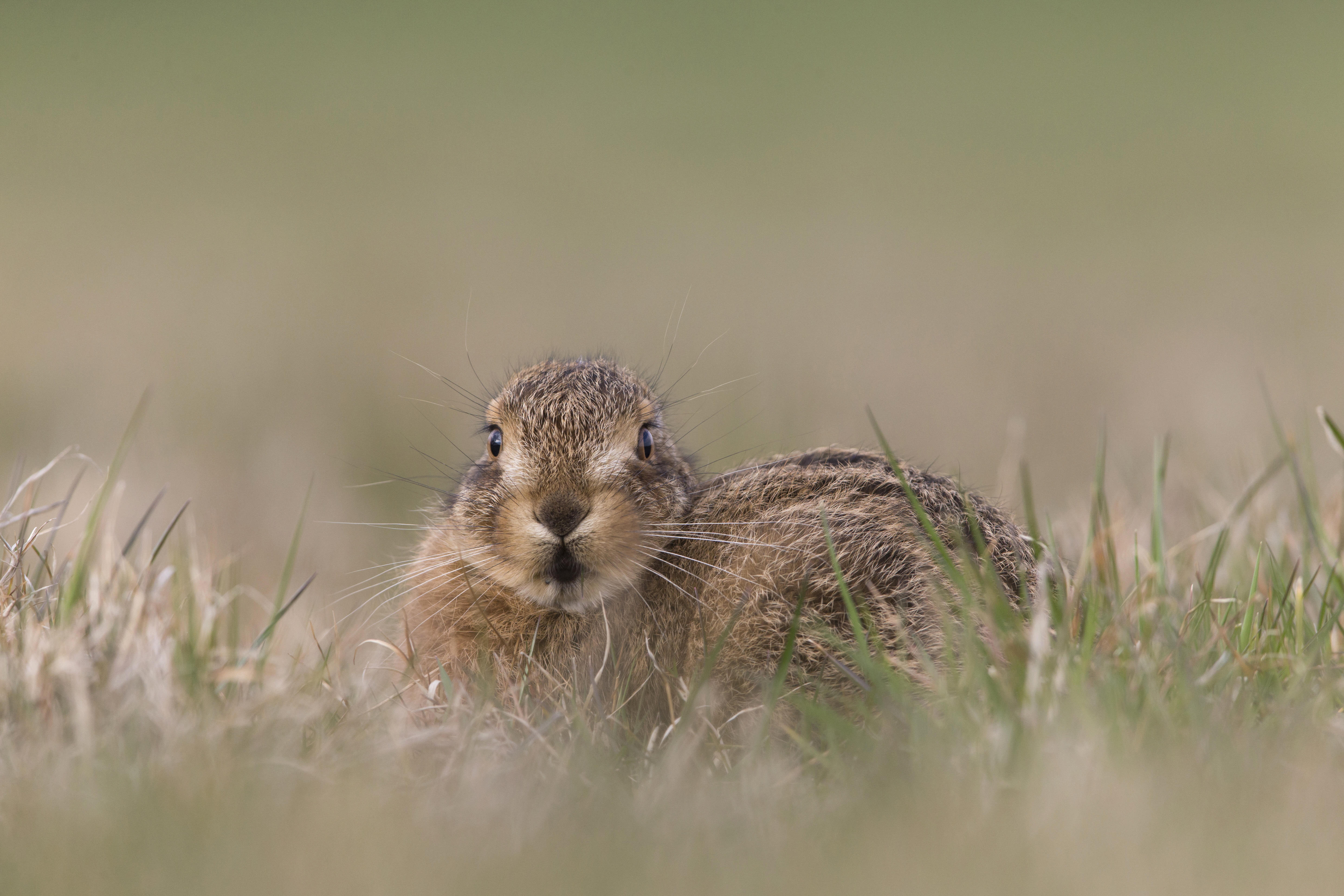 Remembering the Country Life Quiz of the Day by doing the Country Life Quiz of the Day, December 2, 2025
Remembering the Country Life Quiz of the Day by doing the Country Life Quiz of the Day, December 2, 2025Today's quiz is about the quiz. Every question has been asked before. Can you get 10/10?
-
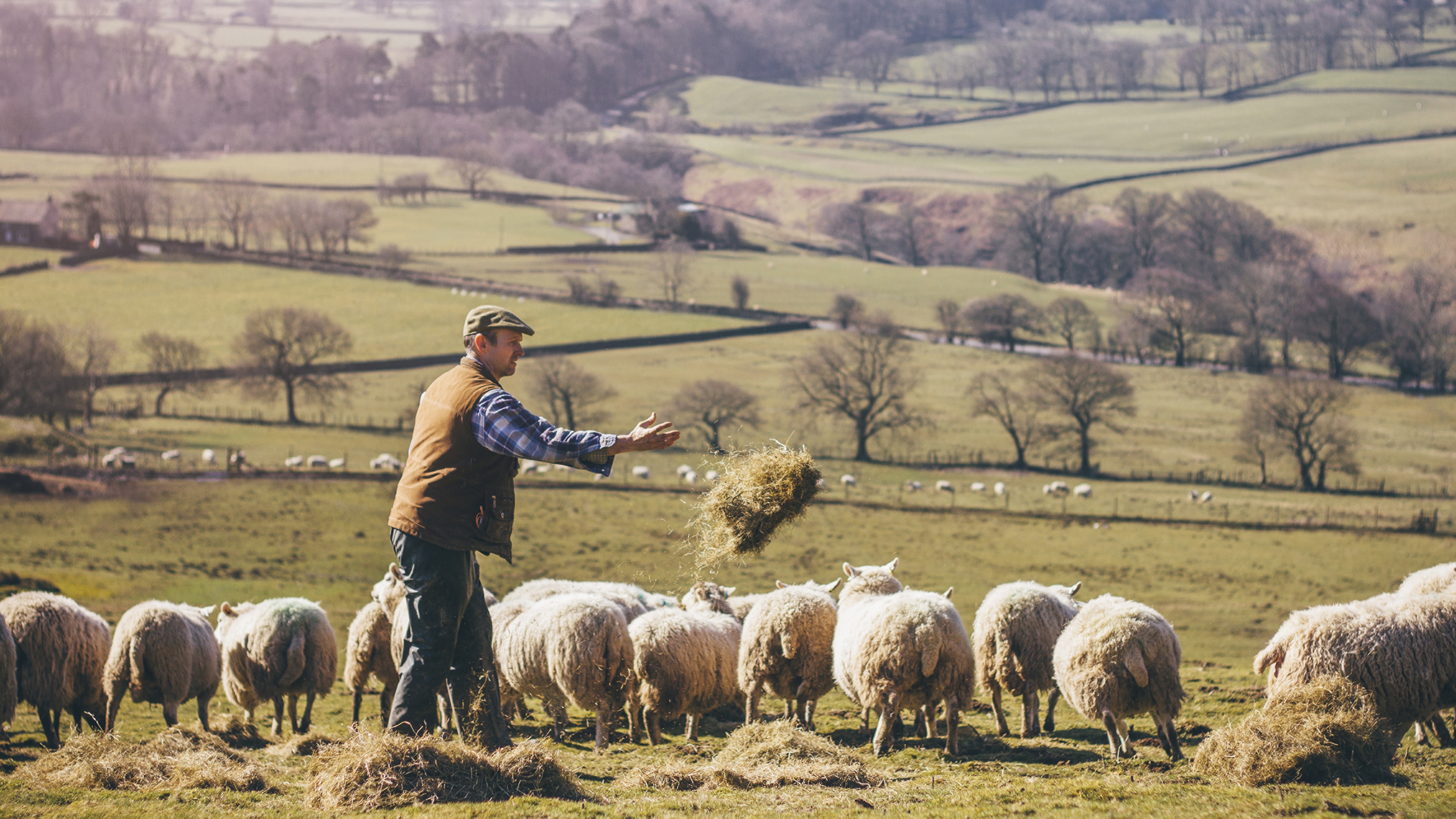 I was Jeremy Hunt’s main political adviser and helped put together multiple Autumn Statements and Budgets. This is what I think Rachel Reeves’s Budget means for the countryside
I was Jeremy Hunt’s main political adviser and helped put together multiple Autumn Statements and Budgets. This is what I think Rachel Reeves’s Budget means for the countrysideAdam Smith, former chief of staff to the Chancellor of the Exchequer, reflects on what last week's Budget means for the countryside and how we ensure the rural voice is heard loudly inside Budget preparations.
-
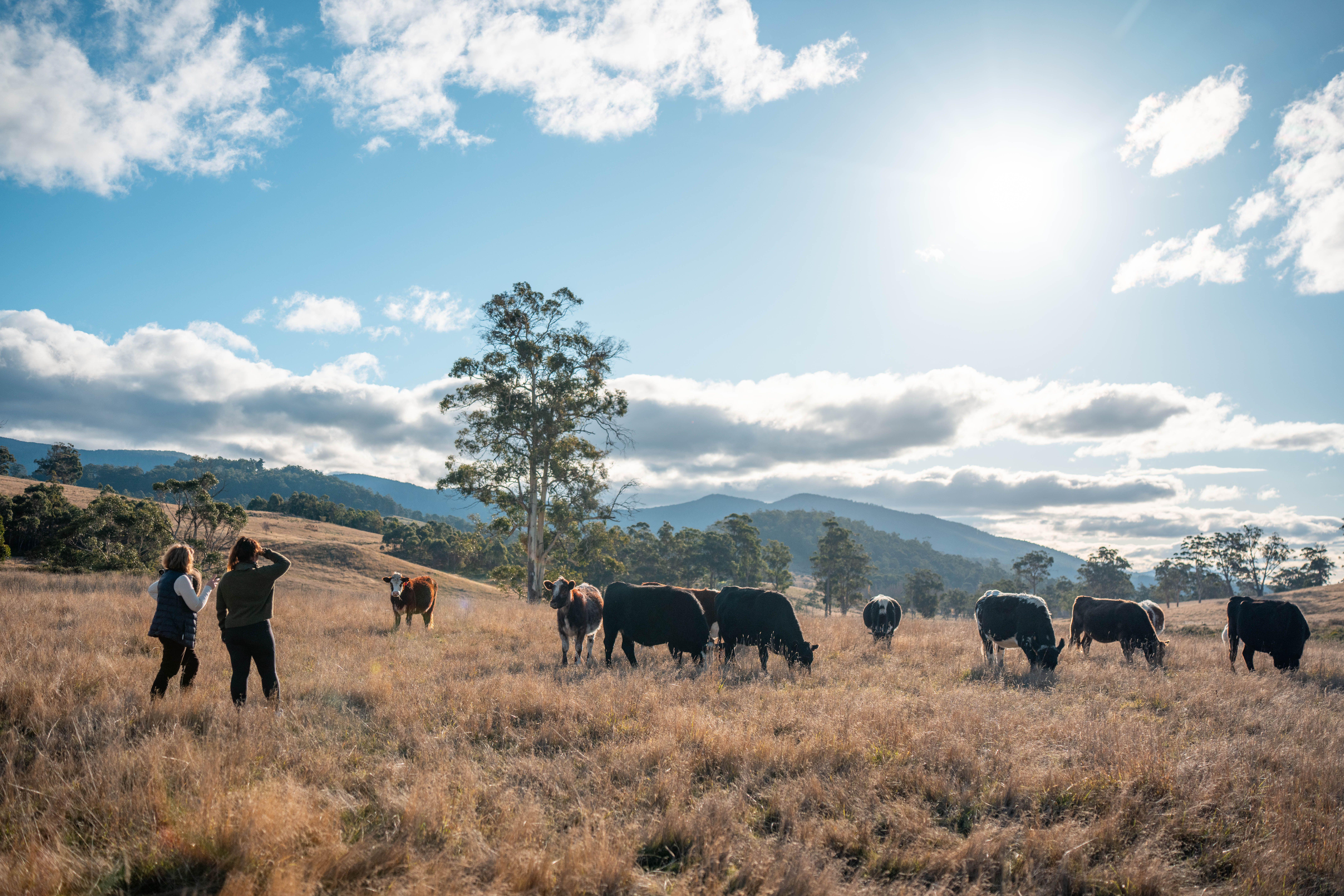 The Budget: What do we need to fix a broken countryside, and what will we get?
The Budget: What do we need to fix a broken countryside, and what will we get?With the Autumn Budget looming, countryside and heritage organisations reveal what they are hoping to hear to fix the turmoil — and what they are dreading
-
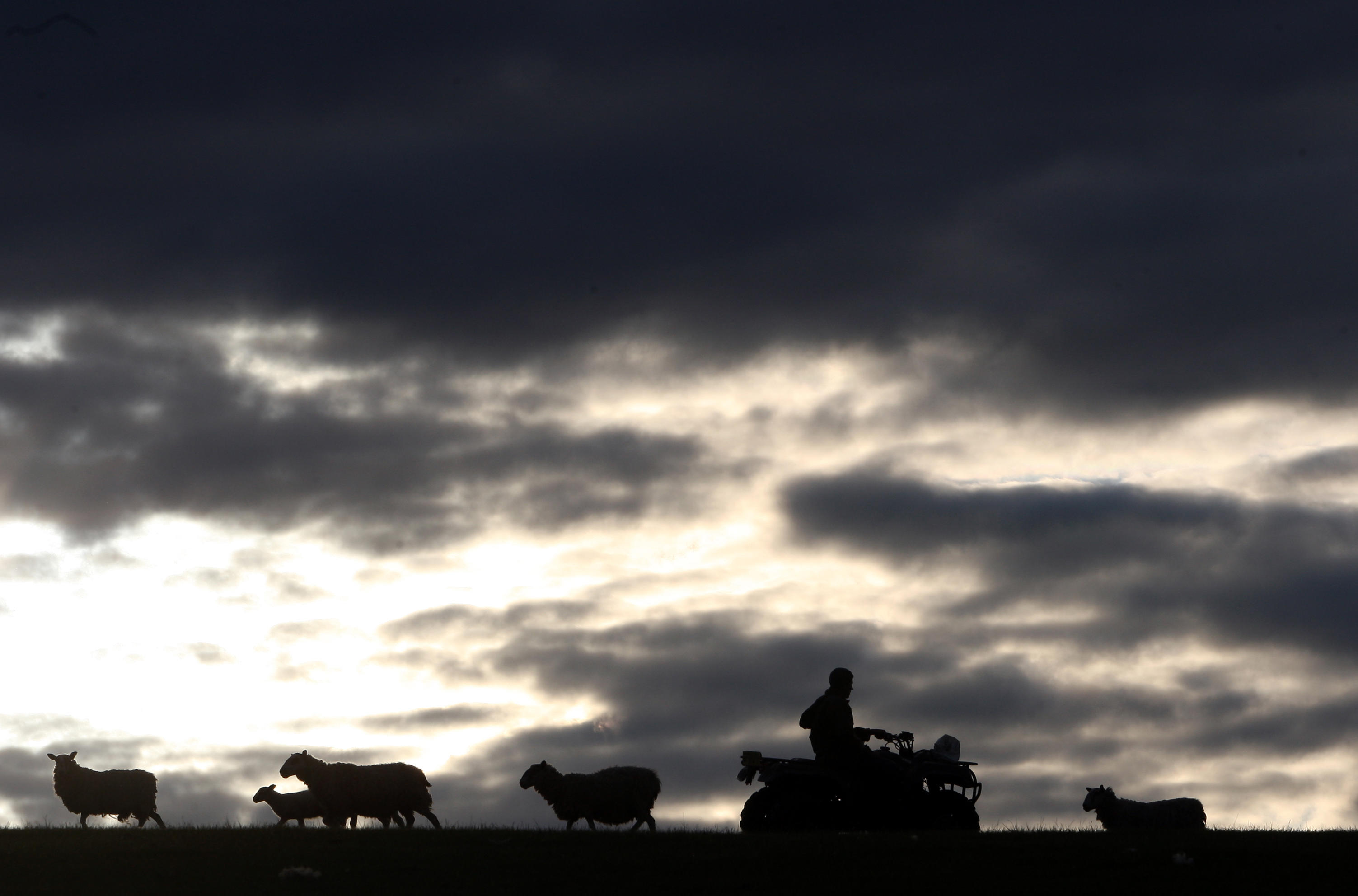 'I’m going to be the first in more than 100 years to sell anything off': How the upcoming budget uncertainty is impacting young farmers
'I’m going to be the first in more than 100 years to sell anything off': How the upcoming budget uncertainty is impacting young farmersChanges to inheritance tax, property relief and Defra budgets will likely change Britian's rural landscape. We ask the next generation of farmers what they think their future will look like.
-
 An unfenced existence: Philip Larkin's love of the countryside
An unfenced existence: Philip Larkin's love of the countrysideRichard Barnett pokes at Larkin’s protective carapace of soot-stained gloom and finds a writer with an unillusioned yet tenderly perceptive sense of Nature, in all its beauty and indifference
-
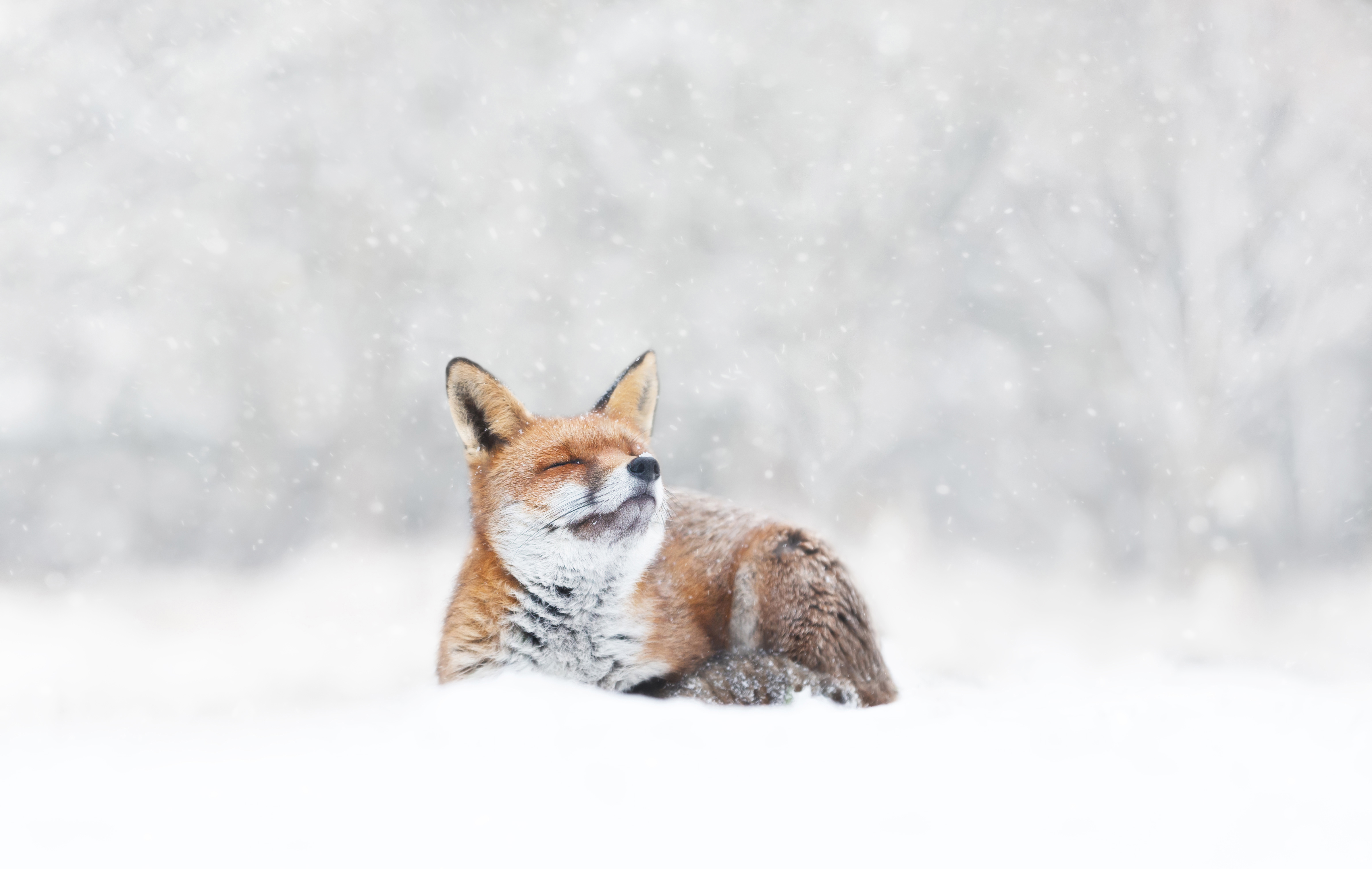 Baby, it’s cold outside (even if you have a natural fur coat): How our animals brave the winter chill
Baby, it’s cold outside (even if you have a natural fur coat): How our animals brave the winter chillWhen the temperature drops, how do Britain’s birds, beasts and plants keep the cold at bay? John Lewis-Stempel reveals Nature’s own thermals.
-
 Retro rubbish: Waste from the 90s unearthed in 97-mile-long beach clean
Retro rubbish: Waste from the 90s unearthed in 97-mile-long beach cleanThe 6,482 volunteers unearthed waste discarded decades ago among the 232,229 pieces of litter recorded during the initiative.
-
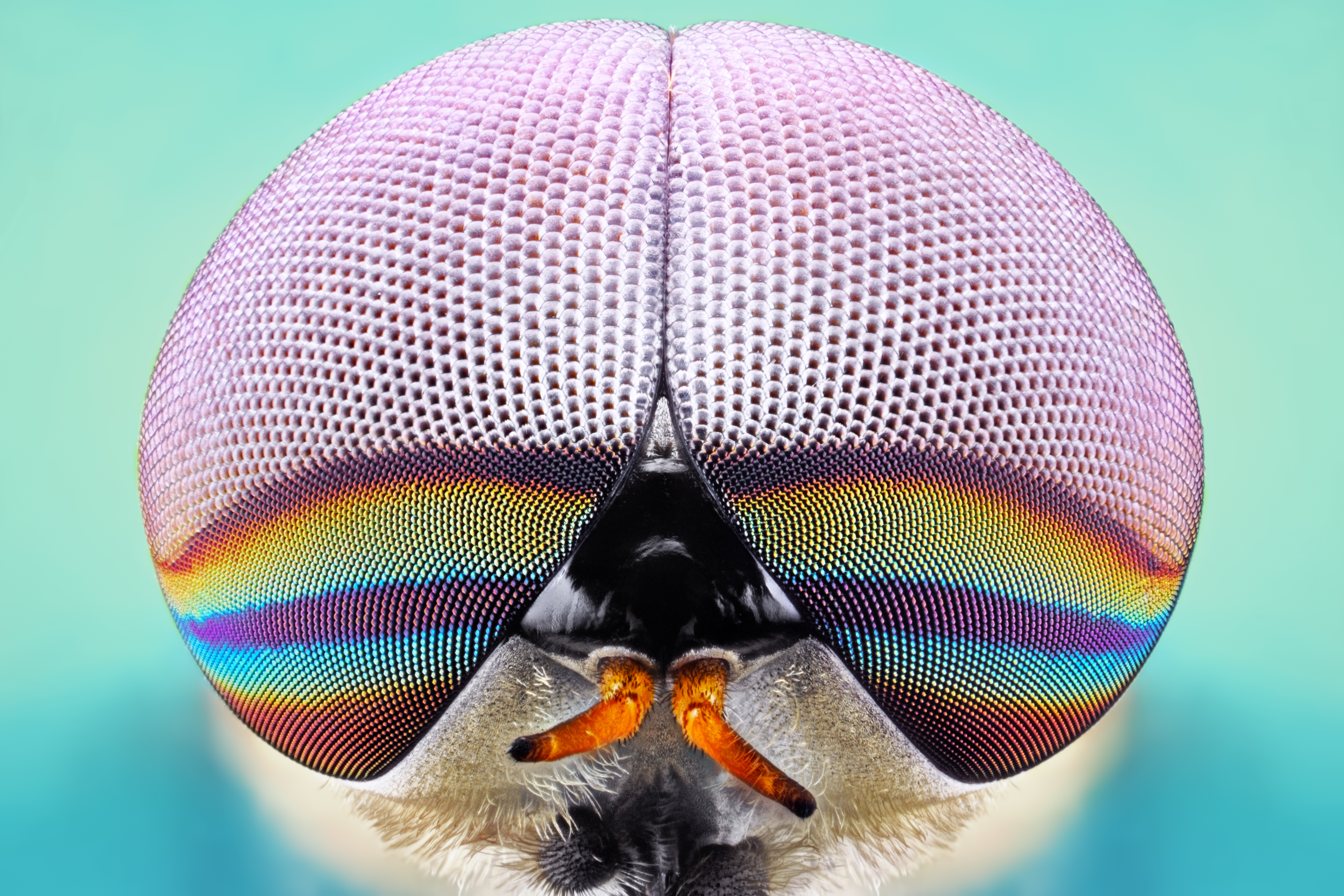 Dangerous beasts (and where to find them): Britain's animals that are best left alone
Dangerous beasts (and where to find them): Britain's animals that are best left aloneJohn Lewis-Stempel provides a miscellany of our otherwise benign land’s more fearsome critters.
-
 Mystery, muse and metaphor: There's more to fog than meets the eye
Mystery, muse and metaphor: There's more to fog than meets the eyeSmothering, transformative and beautiful, fog’s close-set shroud has inspired titans of literature, cinema and art — and forces the rest of us to look at the world a little closer.
